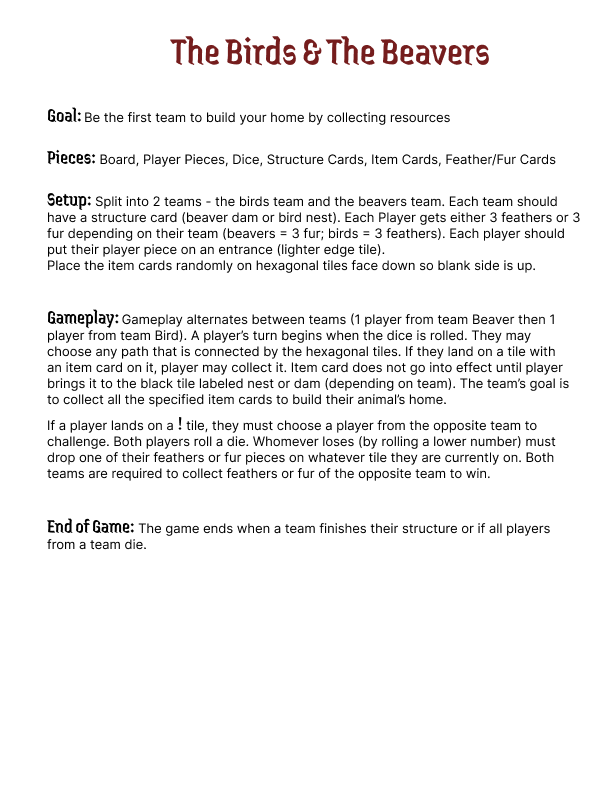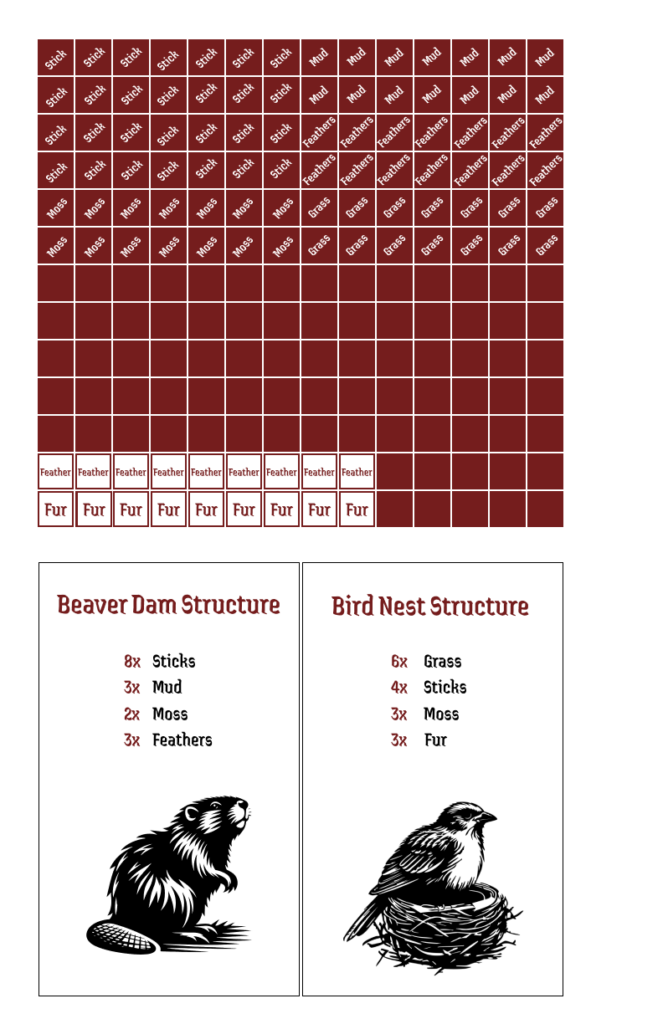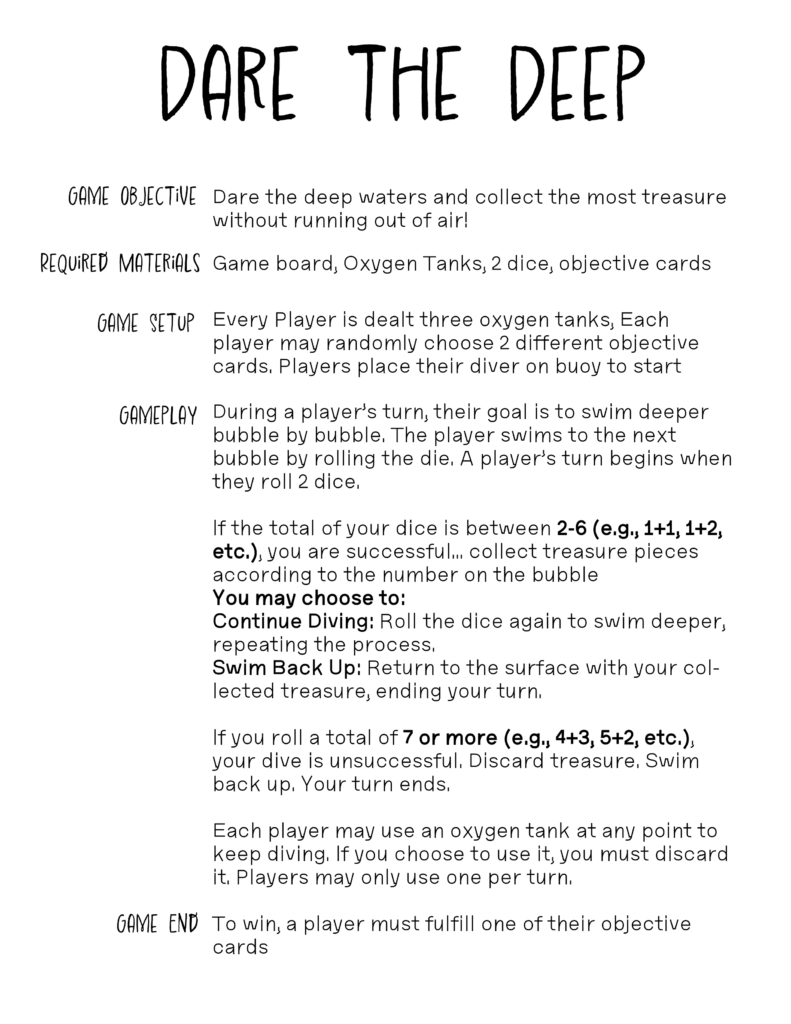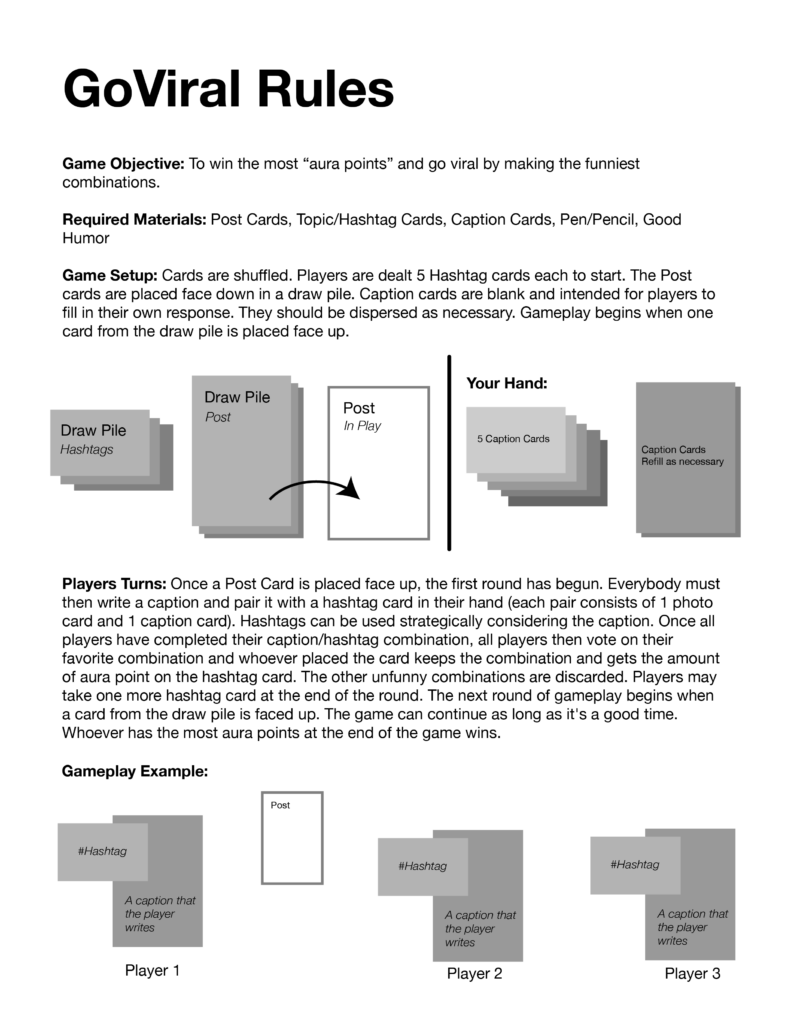Anansi’s Web of Tricks Gameplay
Gameplay Mechanics
Setup
- Shuffle the deck and deal 5 cards to each player.
- Place the remaining cards in the center as the draw pile and flip the top card to start the discard pile.
- Each player selects a Character Card to play as, gaining access to their unique ability.
PS; take note of your characters ability and USE THEM TO YOUR ADVANTAGE
TURN STRUCTURE.
Players take turns performing one major action per turn, keeping gameplay quick and fluid:
- Play a Card: Match the suit or number of the top card on the discard pile.
- Play a Mischief Card: Use special cards to disrupt opponents.
- Use a Character Ability: Activate a unique skill to gain an advantage.
- Draw a Card: If no other action is possible, draw from the deck.
Card and Effects
- Numbered Cards: Match by suit or number to discard.
- Mischief Cards:
- Steal: Take a card from another player. The victim draws 2 new cards (4 if it was their last card).
- Forced Draw: Make a player draw 3 cards. If they play one immediately, you draw 2 cards as a penalty.
- Vortex Shuffle: Shuffle and redistribute hands among up to 3 players.
- Wild Distractions: Target one player to pass you a card of a specific suit. They draw 2 cards if they can’t.
- Nullify: Cancel the last Mischief Card or ability used.
- Mischief cards once played goes in the discard pile
- Character Abilities: Once-per-round powers that enhance strategy (e.g., swapping cards, skipping turns, or blocking Mischief effects).
- Once the draw pile is empty, shuffle the discard pile to make a new draw pile, leaving the last discarded card face-up. If the last card is a Mischief card, randomly select a card from the shuffled pile to replace it. Play continues until only two players remain, battling it out for the final victory.
Winning Conditions
“It’s a race to the finish! The first player to discard their cards is wins, but the fun doesn’t stop there. The remaining players face off in a nail-biting showdown. The goal is to not be the last player standing, as the final two players will compete for the ultimate victory.”
Anansi Web of tricks Third Playtest: Final Observations and Adjustments
Third Playtest: Final Observations and Adjustments
Feedback:
The third playtest demonstrated the near-final state of Anansi’s Web of Tricks, showcasing its refined mechanics and balanced gameplay. The reception was overwhelmingly positive, with only a few minor insights to consider:
1. Dynamic Interaction:
• Players praised the high level of interaction throughout the game. Mischief Cards and character abilities encouraged strategic thinking and constant engagement between players.
• The combination of sabotage, strategic defense, and adaptability made every round unpredictable and exciting.
2. Replayability:
• Testers highlighted the game’s replay value due to the variety of character abilities and Mischief Card effects. No two games felt alike, which encouraged players to experiment with different strategies across multiple sessions.
3. Balanced Abilities:
• Adjustments made during the second playtest to balance character abilities were well-received. Players felt that no single character was overpowered and that every ability had clear strengths and weaknesses.
• For example:
• Anansi’s card swap was impactful without feeling unfair due to its once-per-round limitation.
• Fari the Hyena’s laugh mechanic now provided a consistent and enjoyable disruption to opponents, adding humor to the gameplay.
4. Reduced Downtime:
• The streamlined Mischief Card rules significantly reduced delays during play. Targeted effects (e.g., Steal or Wild Distractions) resolved quickly, allowing the game to maintain a steady pace.
Notes from Testing Across Age Groups:
1. Learning Curve:
• Younger players (ages 10-15) adapted quickly to the mechanics, especially the use of character abilities. The thematic connection between characters and their powers resonated strongly with this group.
• Older players (ages 25+) took longer to grasp the concept of character abilities, often defaulting to playing Number Cards or Mischief Cards during their first few rounds. However, after 1-2 games, this group also began to incorporate abilities into their strategies effectively.
2. Time to Learn:
• On average, it took 2 games for individuals to fully understand the interplay between card types, Mischief effects, and character abilities. Afterward, players found the game intuitive and engaging.
3. Group Dynamics:
• Testers noted that the game excelled in creating lively, competitive group dynamics. The mix of strategy and chaos kept all players invested, even when they weren’t in the lead.
Anansi Web of tricks Second Playtest: Observations and Adjustments
Second Playtest: Observations and Adjustments
Feedback:
After the changes implemented following the first playtest, the second playtest revealed several positive improvements and areas for minor refinement:
1. Improved Game Flow:
• Players noted that the simplified turn structure (one major action per turn) made the game much smoother and faster.
• The pacing issues from the first playtest were largely resolved, with rounds progressing quickly without feeling rushed.
2. Balanced Offense and Defense:
• The rebalanced Mischief Cards and character abilities created a satisfying interplay between offensive actions (e.g., Steal, Forced Draw) and defensive strategies (e.g., Tiko the Tortoise’s ability to block Mischief Cards or Zari the Owl’s ability to draw and discard strategically).
• Players felt that they had meaningful choices each turn, contributing to a sense of control and engagement.
3. Card Readability:
• While the game mechanics were praised, players suggested improving the visual design of the cards for better readability.
• Specific Issues: Fonts for numbers and card effects were sometimes too small or overly stylized, making them harder to read at a glance.
• Impact: This caused minor delays during gameplay, particularly for new players unfamiliar with the card effects.
4. Character Abilities:
• Although the abilities were better balanced compared to the first version, some characters still felt slightly overpowered or underwhelming:
• Overpowered: Anansi’s ability to swap a card remained strong, particularly when combined with certain Mischief Cards.
• Underwhelming: Fari the Hyena’s ability to skip an opponent’s turn by making them laugh felt inconsistent in effectiveness.
Anansi Web of tricks(1st Playtest)
1st Playtest
During the first playtest, several critical issues surfaced that needed attention to make Anansi’s Web of Tricks more enjoyable and accessible:
1. Pacing Issues:
• Players often took a long time to complete their turns because they had too many options available (e.g., playing Number Cards, using Mischief Cards, activating character abilities, and drawing cards all in one turn).
• The combination of multiple actions led to decision fatigue, especially for younger players in the target age range of 10+.
2. Disruptive Mischief Cards:
• Certain Mischief Cards, such as the original version of Wild Distractions, which forced all players to pass cards to one another, caused significant delays and confusion.
• Group-wide effects often felt frustrating for players who had carefully planned their strategies, only to have their progress upended without much recourse.
3. Rule Complexity:
• Players struggled to follow the game’s flow because the rules for Mischief Cards, character abilities, and the multiple actions allowed in one turn were not clearly delineated.
• Younger players found it hard to track which cards were played and what their effects were, leading to slower rounds and frequent rule clarifications.
WEEK 6
Concept and Rule Set: Anansi the trickster
PROTOTYPE 1
• Theme: Inspired by Anansi, the trickster spider, with gameplay focused on outwitting opponents.
• Objective: Be the first player to discard all cards while using abilities and trick cards to sabotage others.
• Deck Composition:
• Number Cards: 30 cards across 3 suits (Trick, Trap, Action), numbered 1-10.
• Trick Cards: 40 cards with various actions (e.g., stealing cards, reversing turns, forcing draws).
• Wild Cards: 10 cards to match any suit or number.
• Character Cards: 10 unique trickster characters, each with special abilities.
• Turn Structure:
1. Play a card to match the top card on the discard pile by suit or number.
2. Play a Trick Card or Wild Card at any time.
3. Use character abilities at any time during a turn.
4. Draw a card if no playable options exist.
• Winning: First player to discard all cards wins.
Rotten to the Core Rules – Collab with Sara
Evelyn and Tori: The Birds & The Beavers
Lauren Yunk – Game Ideas
Evelyn: Dare the Deep
The Lamp Rules – Version 2
Made a few minor tweaks to the game based on playtest feedback
Art Heist
What was the most fruatrating moment or aspect of what you just played? keeping track of where everyone was
What was your favorite moment or aspect of what you just played? getting to blame the other players
Was there anything you wanted to do that you couldn’t? no
If you had a magic wand to wave, and you could change, add, or remove anything from the experience, what would it be? add other jobs because the joker is the only one who actually reaches for the art
What should be improved with the next version? more reasons to reach for the art because its obvious who it is if only one person is reaching for it.
Descibe the game in 3 words? mysterious, active, interesting
Bear Heist
What was the most fruatrating moment or aspect of what you just played? Being creative enough to figure out what to do
What was your favorite moment or aspect of what you just played? The chance of seeing if youll roll under a 3
Was there anything you wanted to do that you couldn’t? nope
If you had a magic wand to wave, and you could change, add, or remove anything from the experience, what would it be? I like the game how it is
What should be improved with the next version? Maybe add more characteristics for the bears
Descibe the game in 3 words? fun, creative, collaborative
To Feed or Not to Feed
What was the most fruatrating moment or aspect of what you just played? Picking up only low cards
What was your favorite moment or aspect of what you just played? getting to feed my animals
Was there anything you wanted to do that you couldn’t? no
If you had a magic wand to wave, and you could change, add, or remove anything from the experience, what would it be? add a rule for what happens if you tie
What should be improved with the next version? I think its pretty solid and a lot of the changes were added already
Descibe the game in 3 words? fun, competitive, intresting
Jokes on You Prototype 2
Players: 3-6
Setup: Shuffle the deck including the Jokers. Deal 7 cards to each player. Place the remaining cards in the middle of the table with another card placed next to it face up.
Gameplay: The goal of the game is to be the first person to get a run of 7 cards. A run is 7 cards in numerical order that are all the same suit(7♠ ,8♠, 9♠, 10♠, J♠, K♠, Q♠). You can pickup from either deck, but you can only grab from the top of the deck. The first player discards to the person to the right. Always pickup a card first and discard last. The rest of the game the players discards to the discard pile and the person to their right. The card discarded to the right will wlays remain faced down. If you pick up a Joker, you can use that card to take someone elses card from their hand. Once the Joker is used it goes into the discard pile and cannot be picked up again unless the deck is shuffled. Frist person to get their run and says “Jokes on You” is the winner.
Other Rules: If you run out of cards, reshuffle the deck
The run does not have to start at ace/one, you can start at any number as long as you can get 7 in a row. (you can’t start at Queen as you can only get two cards past it)
Garden Glory
Rule Book
Objective of the Game
Grow the most valuable garden by cultivating various plants and herbs throughout the seasons. Score points by selling your harvests, completing bundles, and utilizing seasonal advantages.
Required Materials
- 4 Planter Boxes (player boards)
- 1 Season Tracker Board
- 12 Plant Cards per season (Spring, Summer, Fall, Winter)
- 10 Bundle Cards
- 20 Buff Tokens
- 1 Score Tracker
- 1 Dice (six-sided)
- 4 Player Tokens
- 1 Rule Book
Setup
- Season Tracker Board: Place it in the center and set it to Spring.
- Planter Boxes: Give each player a Planter Box and place it in front of them.
- Plant Cards: Shuffle the plant cards for each season separately and place them face down next to the Season Tracker.
- Bundle Cards: Shuffle and place these face down near the plant cards.
- Buff Tokens: Place these in a common area accessible to all players.
- Score Tracker: Place the score tracker where all players can see it.
Player Turn Order
- Players take turns in clockwise order, starting with the player who most recently planted something.
Starting Resources
Each player starts with:
- 2 Plant Cards (drawn from the Spring pile)
- 1 Buff Token
- 5 points on the Score Tracker
Growth Mechanic
Growth Stages
- Each plant card has a growth time indicated on it (1 to 3 turns).
- Example:
- Basil: 1 turn
- Mint: 2 turns
- Tomato: 3 turns
- Example:
Growth Tracking
- When you plant a card, place it in your Planter Box and use a marker to indicate it is “growing.”
- At the start of your turn, check which plants are ready to be harvested based on their growth time.
Player’s Turn Structure
Each player’s turn consists of the following steps:
- Draw Phase:
- Draw 1 Plant Card from the current season’s pile.
- Action Phase:
- Perform two of the following actions:
- Plant a Plant Card: Place a card from your hand into your Planter Box. Ensure it’s currently in season.
- Sell Plants: Declare and sell any fully grown plants for points.
- Purchase Buff Tokens: Spend points to acquire Buff Tokens.
- Draw an Additional Plant Card: Draw another card from the current season’s pile.
- Perform two of the following actions:
- Buff Usage (Optional):
- Use Buff Tokens at any appropriate time during your turn, such as when selling or planting.
- End of Turn:
- Your turn ends, and play passes to the next player.
Example of a Player’s Turn
- Draw Phase: You draw 1 Plant Card from the Spring pile.
- Action Phase:
- You plant a Mint (2 turns to grow).
- You sell a Basil (1 turn to grow) for 5 points, using a Harvest Boost for an additional 2 points, totaling 7 points.
- Buff Purchase: You buy an Out-of-Season Planting Buff for 3 points, leaving you with 2 points.
- End of Turn: Your turn ends, and the next player takes their turn.
Buff Tokens
Types of Buffs
- Harvest Boost: Adds +2 points when selling plants.
- Plant Swap: Swap one Plant Card from your hand with another player’s Plant Card.
- Out-of-Season Planting: Plant one card that’s not currently in season.
- Extra Draw: Draw an additional Plant Card from the current season’s pile.
Acquiring Buff Tokens
- Buff Tokens can be purchased during your turn using points (3 points each).
Harvesting Plants
- At the start of your turn, check your Growth Tracker:
- If a plant has completed its growth time, it can be harvested for points.
- If it hasn’t matured, it remains in the growing state.
End of Turn/Round
- After all players have taken their turns, advance the Season Tracker one step.
- When a season ends, all players discard their hand and draw new Plant Cards from the next season’s pile.
Winning and Losing
The game ends after all four seasons have been completed.
- The player with the most points wins.
Visual Examples

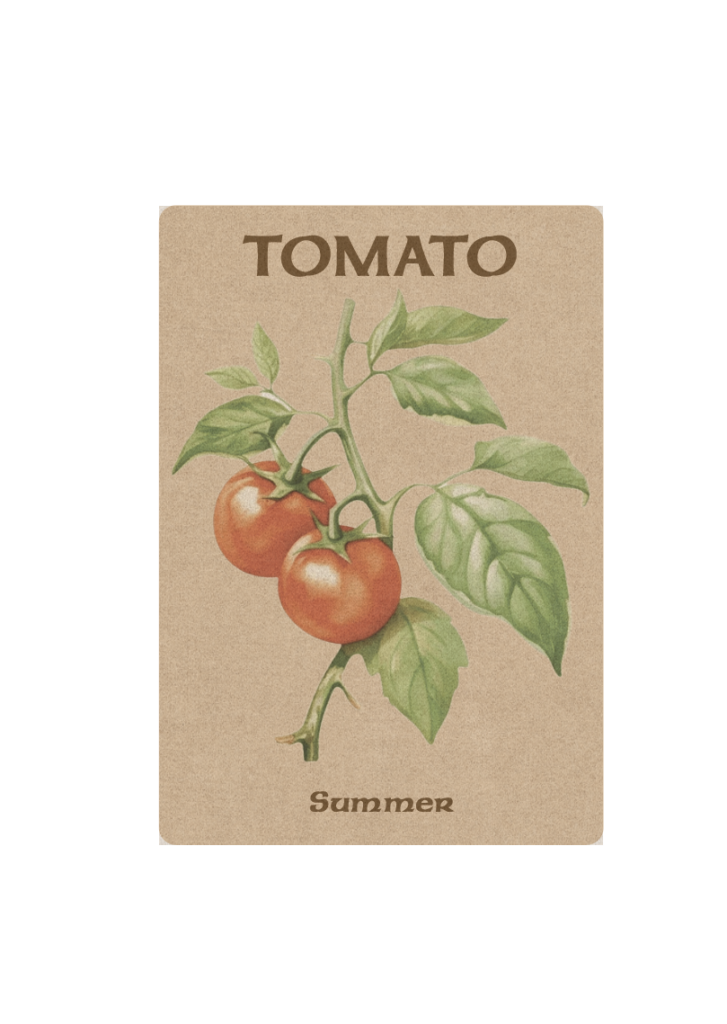

Additional Details
Plant Cards
- Each card displays a plant name, growth time, and points for harvesting.
Bundle Cards
- Show the types of plants needed for completion, offering bonus points when fulfilled.
Final Note
Manage your time and resources wisely! The key to victory is strategic planting, careful use of Buffs, and timing your harvests. Enjoy growing your garden in Garden Glory
Treasure Hunt
Objective:
Be the first player to collect 5 treasure cards.
Setup:
– Treasure Cards (10 cards): Write “Treasure” on 10 of the cards.
– Trap Cards (5 cards): Write “Trap” on 5 cards.
– Action Cards (15 cards): These cards allow players to perform different actions.
Action Cards:
– Steal: Take 1 treasure from another player.
– Protect: Block the next “Steal” or “Trap” action played against you.
– Double Draw: Draw 2 extra cards on your turn.
– Lose a Turn: Skip your next turn.
-Trade: Swap 1 card with another player.
Shuffle all the cards together and place them face down in a deck.
Gameplay
1. Each player starts with 3 cards.
2. On your turn, draw 1 card and then play 1 card (if possible).
3. When you draw a Treasure card, place it face up in front of you. If you draw a Trap card, you must discard one of your treasures if you have any (if not, discard the Trap card).
4. Players can use Action cards strategically to steal treasures, protect themselves, skip other players, draw two cards, or trade,
Winning
The first player to collect 5 treasure cards wins the game!
Optional Variations:
– Add more Action cards with different abilities, like Swap Hands or Discard a Card.
– Increase the number of treasures needed to win for a longer game.


